Acorn jelly, known as dotorimuk in Korean, is a unique and traditional Korean dish made from acorn starch. This jelly has a mildly nutty and earthy flavor with a hint of astringency, making it both intriguing and subtle.
It’s a versatile food that can be sliced and served with a spicy soy sauce dressing or used as a delightful side dish. Known for its light and refreshing qualities, acorn jelly is enjoyed not only for its taste but also for its health benefits.
Many people appreciate that it’s gluten-free and vegan-friendly, fitting well into various dietary preferences. Its smooth texture and delicate flavor profile make it a popular choice among those looking to explore authentic Korean cuisine.
The process of making dotorimuk involves boiling acorn starch powder mixed with water and then letting it cool to a firm, jello-like consistency. Some families in Korea still gather acorns from the mountains to create this jelly from scratch, honoring their culinary traditions.
This simple yet fascinating dish invites everyone to experience a taste of Korea’s rich culinary heritage.
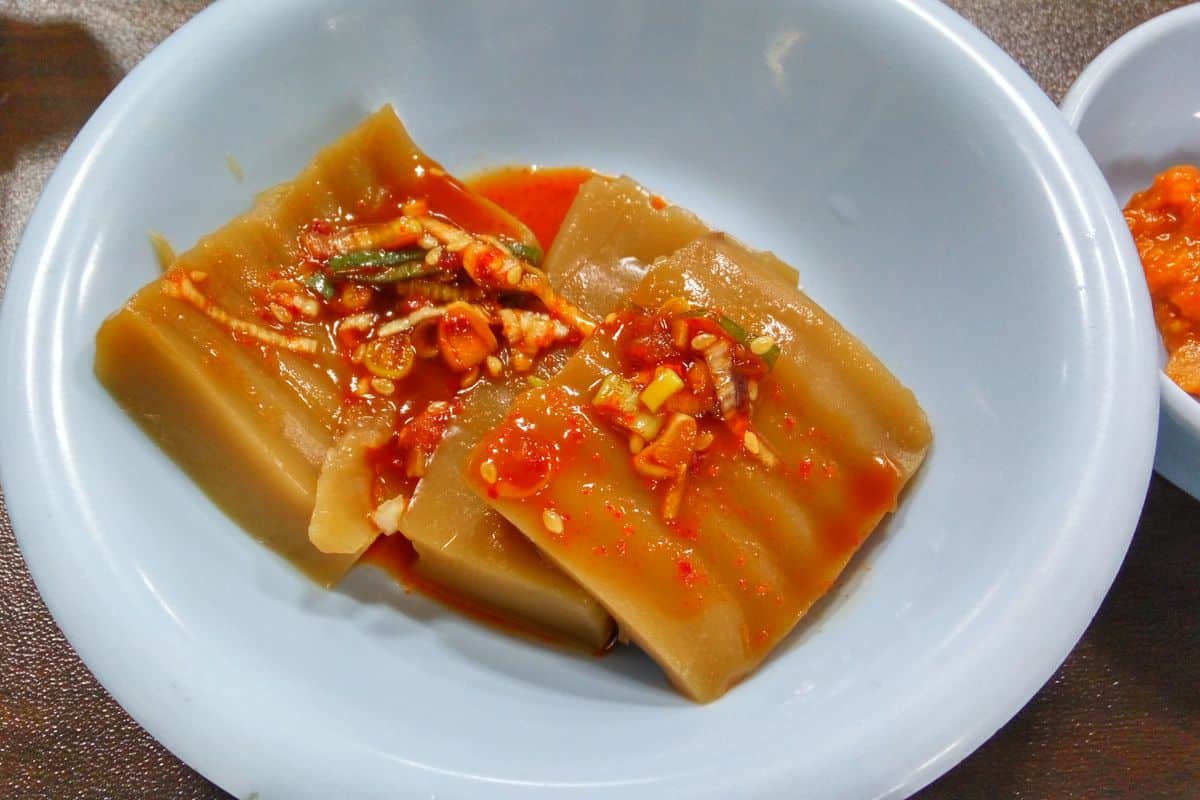
Jump to:
🧐 Historical Context
Acorn jelly originated in the mountainous areas of ancient Korea. During the Joseon Dynasty, when King Seonjo reigned, people often faced food shortages. Villagers found that acorns from oak trees were abundant and began to use them as a food source.
Acorns were gathered, shelled, dried, and made into powder. This powder was then mixed with water to create a jelly. This method provided a way to use acorns as a nutritious and filling food.
The process of making dotorimuk was not just a survival tactic. It became embedded in Korean culture. The practice of making and eating acorn jelly has been passed down through generations and holds a unique place in Korean culinary traditions.
Traditionally, dotorimuk was used in various Korean recipes. It’s often sliced into thick squares and served with a spicy soy sauce. This dish is known for its mild, nutty taste and slightly astringent flavor.
During the Joseon Dynasty, acorn jelly was a valuable food during times of refuge. King Seonjo and his people, when seeking refuge in the mountains, relied on dotorimuk as a vital source of nutrition.
Today, dotorimuk is still enjoyed in many Korean households. It's often garnished with toppings like sesame seeds, soy sauce, or pickled cabbage, connecting to Korean heritage and history.
🌰 Acorn Jelly Basics
Acorn jelly, known as dotorimuk in Korean, is a fascinating dish with unique flavors and textures. It's made from acorn starch and has a mild, nutty taste.
Acorn jelly is a traditional Korean food made from acorn starch or acorn flour. The process involves cooking dried acorn powder with water until it turns into a thick paste.
After cooling, it solidifies into a jelly-like consistency. Koreans typically slice it into thick squares and serve it with a spicy soy sauce. The flavor of acorn jelly is mild, with hints of nuttiness and a slight astringent taste.
Despite its gelatin-like appearance, it doesn't contain any gelatin. Instead, the natural starch found in acorns gives it its unique texture.
Acorn jelly comes in several forms. One popular variation is seasoned acorn jelly, known as dotorimuk-muchim, which involves tossing the jelly in a mix of soy sauce, garlic, sesame oil, and other spices.
Another version includes acorn jelly with chrysanthemum leaf salad, which combines the jelly with fresh greens and a spicy dressing. Some people in Korea still gather acorns themselves, shell, dry, and powder them to make homemade acorn jelly.
Whether homemade or purchased, each form offers a unique taste and texture experience, keeping this traditional dish versatile and beloved.
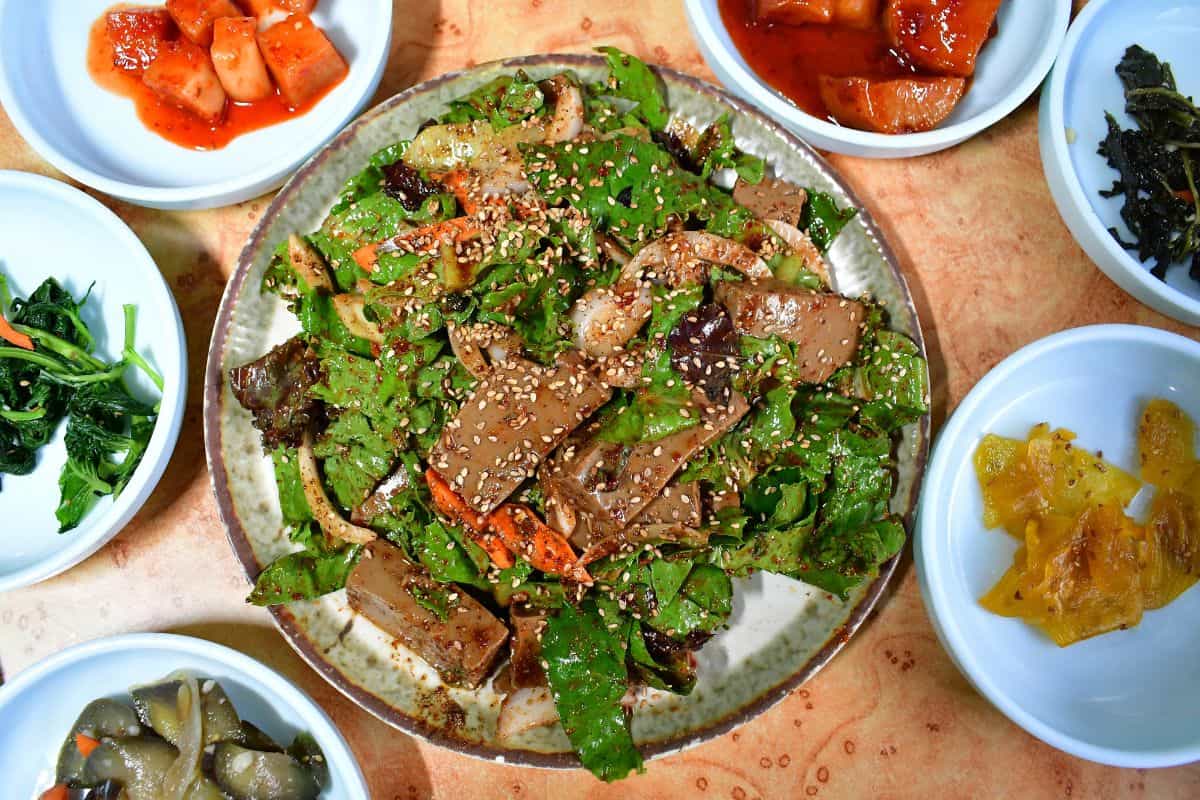
👨⚕️ Nutritional Profile
Health Benefits
Dotorimuk is packed with fiber, which aids in digestion and helps maintain a healthy digestive system. Regular intake of fiber-rich foods can prevent constipation and promote regular bowel movements.
The jelly also contains antioxidants. These can protect the body from oxidative stress and reduce inflammation. This makes acorn jelly a good choice for people looking to improve their health.
Rich in minerals like calcium, iron, and magnesium, dotorimuk can support bone health. Iron is essential for preventing anemia, while magnesium is crucial for muscle function.
Dietary Information
Acorn jelly is incredibly low in calories. A 100-gram serving usually has around 40 calories, making it an excellent choice for those watching their weight. Despite being low in calories, it provides a feeling of fullness due to its high fiber content.
The jelly is naturally gluten-free and suitable for people with celiac disease or gluten sensitivity. It’s vegan and vegetarian, made entirely from acorn starch and water.
Nutritionally, dotorimuk offers a small amount of protein and minimal fat. It's not a significant source of vitamins but can be a healthy addition to a balanced diet when combined with other nutrient-rich foods.
🥣 Preparing Acorn Jelly
From Scratch
To make acorn jelly from scratch, you'll need dried acorns, water, and a few kitchen tools. First, gather and shell the acorns. It's crucial to remove tannins—bitter compounds found in acorns—by soaking them in water.
Fill a large bowl with water, add the shelled acorns, and let them soak. Change the water frequently until it's clear, which can take several hours. This process, called leaching, ensures the acorns aren't bitter.
Once the tannins are leached out, grind the acorns into a fine paste. A blender works well for this. Mix the acorn paste with water and let it sit. The acorn starch will settle at the bottom of the bowl.
Carefully pour out the water and discard it. Next, cook the acorn starch with more water on medium-low heat, continuously stirring until it forms a gelatinous mixture. Pour this mixture into a mold, smooth it out, and let it cool to set.
Store-Bought Prep
Using store-bought acorn starch can significantly reduce preparation time. You'll need the starch, water, and a few basic kitchen tools. Begin by mixing one part acorn starch with 4 parts water in a large pot. Stir the mixture until all lumps are gone. Add a pinch of salt if desired.
Place the pot on the stove over medium-low heat. Stir continuously with a wooden spoon until the mixture starts to thicken and form small gelatinous lumps, typically after about 10 minutes.
Once the mixture has thickened, pour it into a rectangular container and spread it evenly. Let it cool and solidify into jelly.
For a quick and easy option, store-bought starch is ideal. It captures the essence of traditional dotorimuk without the extensive preparation needed for using dried acorns.
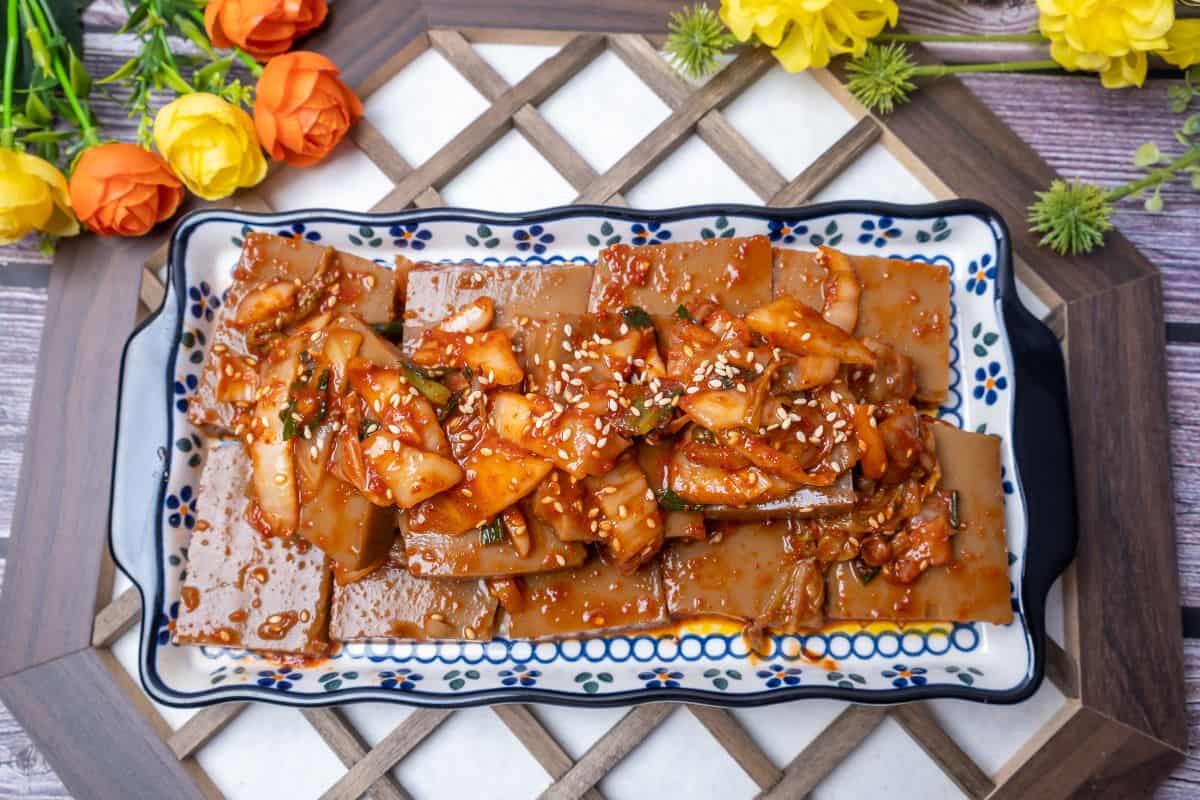
😋 Flavor and Texture
Taste Profile
Acorn jelly has a mild and nutty flavor that many find enjoyable. Due to its subtle earthy taste, it can be paired with a variety of seasonings. Some describe a faint astringent taste at the end, which adds to its unique profile. When plain, its flavor is quite neutral, making it a versatile ingredient in many dishes.
Serving Suggestions
Dotorimuk is commonly sliced into thick squares and topped with a spicy soy sauce. The sauce typically contains ingredients like soy sauce, sesame oil, and chili flakes, which complement the jelly's mildness.
In Korea, it's often served as a side dish, but it can also be used in salads. Mixing acorn jelly with leafy greens and other vegetables can create a refreshing and light dish.
For a more traditional approach, some people prefer making it from scratch using acorn starch powder. This process involves boiling the starch with water and allowing it to cool until it sets like jello but firmer.
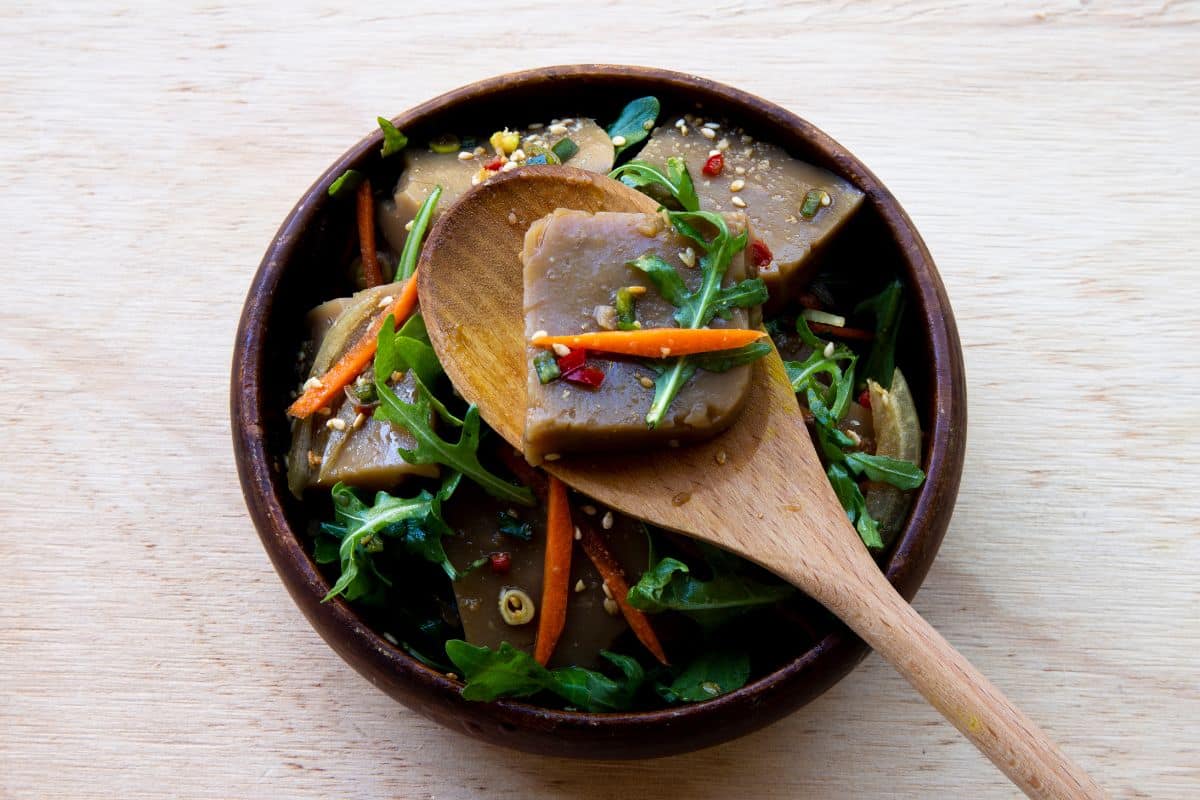
🍱 Common Accompaniments
Sauces and Seasonings
When enjoying acorn jelly, sauces and seasonings play a crucial role in elevating its overall flavor. Soy sauce is a popular choice, providing a salty base that complements the jelly’s mild taste. Sesame oil and toasted sesame oil add a nutty aroma and richness to the dish.
Gochugaru (Korean red chili powder) or red pepper powder can be sprinkled on top for some heat. Garlic is often used for its pungent, savory notes.
Yangnyeomjang, a seasoned soy sauce, combines various ingredients like soy sauce, sesame seeds, red pepper flakes, vinegar, green onions, and sugar to create a complex and flavorful sauce. Vinegar also helps to introduce a tangy taste that contrasts well with the earthy flavor of the acorn jelly.
Pairings
Acorn jelly is typically served with side dishes that have contrasting textures and flavors. Kimchi is a common pairing, providing a spicy and sour element that contrasts with the jelly’s neutral taste.
Vegetables like lettuce or chrysanthemum leaves are often served alongside, adding a fresh crunch. In some recipes, the jelly is garnished with sliced chili and lettuce leaves for added color and texture, as seen in many Korean settings.
Sometimes, the dish is paired with chili sauce for an extra kick or garnished with sesame seeds for a bit of crunch. All these accompaniments aim to balance out the smooth and mild flavor profile of the acorn jelly.
Dotorimuk can also be part of mukbap, a unique dish that serves the jelly with rice and various sides. Simple ingredients like sesame seeds, sea salt, and scallions complement the mild flavor of the jelly. This dish is typically enjoyed as a light, refreshing meal.
For a quick snack or a light salad, acorn jelly can be served cold and with a simple soy-based sauce. Common additions include shredded carrots, sliced cucumbers, and chopped scallions. These vegetables add color and texture, making the dish more appealing and nutritious.
Acorn jelly salads are often enjoyed as part of a banchan, a selection of small, flavorful dishes served alongside the main meal. These salads are easy to prepare and can be customized with various fresh vegetables and seasonings, providing a healthy and tasty option for any occasion.
❓ Frequently Asked Questions
To make acorn jelly, acorn starch powder is mixed with water and salt. This mixture is stirred until it forms gelatinous lumps and then poured into a rectangular container to cool and solidify. It’s often refrigerated for 4-7 hours.
Acorn jelly can be enjoyed in various dishes. One popular option is Seasoned Acorn Jelly, which is mixed with a sauce made of soy sauce, garlic, and sesame oil. It can also be served as a salad with chrysanthemum leaves and gochujang chili sauce.
Acorn jelly is low in calories and contains beneficial nutrients like protein and fiber. It may help in digestion and provide a feeling of satiety. Since it doesn't have many additives, it’s a good option for those following a natural diet.
Acorn jelly has a mild, nutty taste. Its flavor is quite subtle, making it a versatile ingredient that pairs well with various seasonings and sauces. The texture is smooth and slightly gelatinous

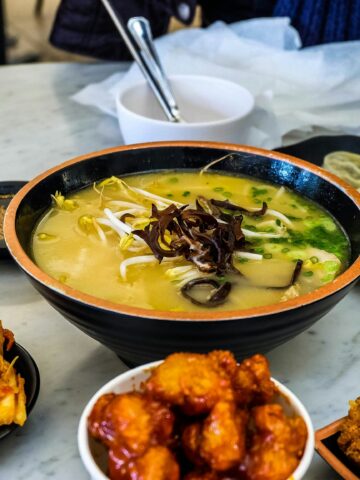
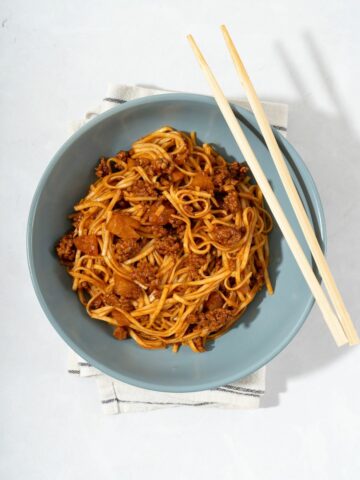
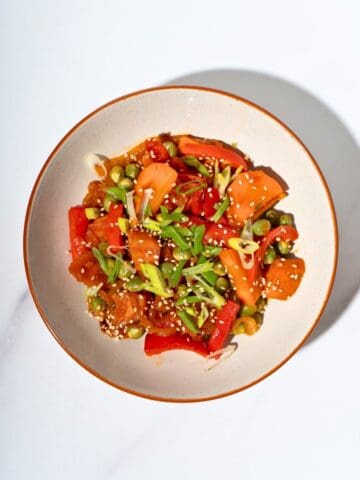
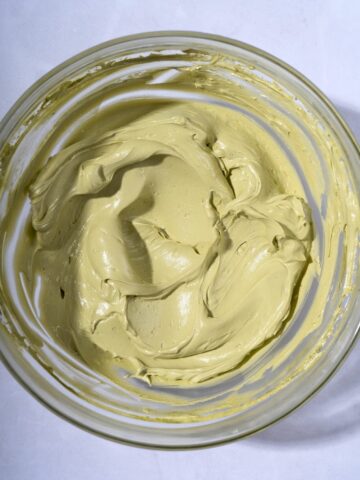
Comments
No Comments